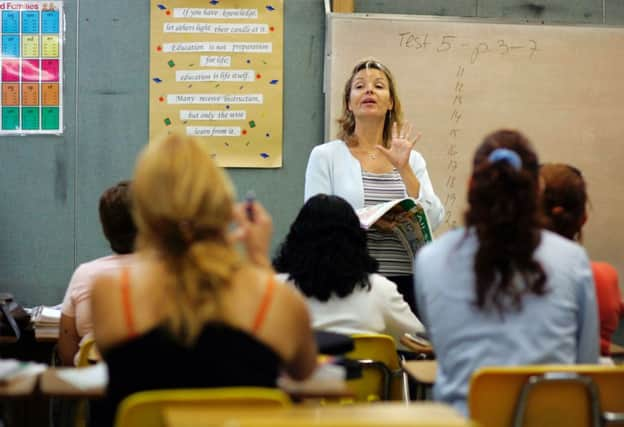Teacher numbers set to fall as cuts take toll


The Scottish Government and local government body the Convention of Scottish Local Authorities (Cosla) is to draw up a new way of measuring pupils’ achievement in the classroom, other than by focusing on statistics such as teacher numbers.
Teacher numbers have been protected under a deal between Cosla and the government, but council chiefs say the deal will end next year and they are ready to take a different approach.
Advertisement
Hide AdAdvertisement
Hide AdBut the Cosla claims have prompted a row with the government which last night warned councils could still face financial sanctions next year if an agreement cannot be struck in forthcoming talks to protect teacher numbers.
Cosla education spokesman Douglas Chapman will appear before Holyrood’s education committee tomorrow to set out the impact of funding pressures.
The swingeing funding cuts of recent years have made balancing education budgets for local councils a “challenge”, a submission to the committee from Cosla stated.
“This is the last year of our existing agreement with government on teacher numbers,” it added. “We believe that we will meet the commitment again when the statistics are published in December, although this is likely to be by a narrow margin. From next year onward we have reached a new agreement with government that should begin shifting the focus away from input measures, such as teacher numbers, towards a more useful measure of educational outcomes.”
CONNECT WITH THE SCOTSMAN
• Subscribe to our daily newsletter (requires registration) and get the latest news, sport and business headlines delivered to your inbox every morning
Council chiefs said they do not want to cut teacher numbers or close schools but insisted they must be able to make “meaningful decisions” about these issues which provide the “biggest pressures” on the education budgets.
Borders Council has already moved to an “asymmetric school week” which sees secondary schools closed on a Friday afternoon and this may be rolled out to save cash, the submission from Cosla policy manager Kathy Cameron said.
It added: “Similarly, looking at the length of the primary school week is another option that councils may considers.”
Advertisement
Hide AdAdvertisement
Hide AdThe most important measure of success in education is “not how much money is spent, or how many teachers are employed or how many schools are built or refurbishment,” the submission said.
Cosla and the government are about to develop a “robust way” of looking at performance. “If successful, we want this to be recognised as the tried and tested way of measuring attainment,” the submission added.
Last week, First Minister Alex Salmond came under pressure as he clashed with opposition leaders at Holyrood over the 4,000 drop in teachers numbers since 2007 to 51,078 last year.
Councils are likely to spend about £4.1 billion on schools in 2014-15 – down 5 per cent over the past three years. Local authorities are warning of major cuts.
Highland Council has warned of potential cuts to classroom hours and a reduction in the school week in plans to save £64 million next year. Glasgow is facing a £28.9m budget black hole next year and £100m over the next three years. In West Lothian, £30.4m needs to be saved and Fife has a budget gap of £77m over the next three years.
Teacher numbers – in ratio to the number of pupils – were protected in a 2011 agreement on pay and conditions. The local government settlement letter this year said the commitment on teacher numbers would continue in 2015-16 but without the financial sanctions that had applied in previous years.
A key driver in the cost of education has been rising pupil numbers. These have been increasing since 2011 and are projected to continue doing so over the next five years. Secondary school pupils have been falling since 2004 and are projected to continue to fall until starting to increase in 2017.
The Scottish Conservatives voiced concern over the prospect of “cuts by stealth”.
Advertisement
Hide AdAdvertisement
Hide AdTory education spokesman Liz Smith said: “We have an education system creaking at the seams. Until we accept that a one-size-fits-all-system is not the best way to teach our children we will continue to fall behind other countries around the world.”
But a Scottish Government spokeswoman last night said councils could still face a financial penalty if a deal cannot be struck on protecting teacher numbers.
She said: “The Scottish Government and local authorities have a shared a commitment to maintain teacher numbers in line with pupil numbers for this financial year – a commitment we have delivered in previous years. Discussions are under way with Cosla, local authorities, teacher unions, parent bodies and others on the best way to measure a broader range of educational outcomes, including teacher numbers as an important factor in the future.
“If these discussions do not reach a satisfactory agreement the existing commitment and financial agreements will remain in place.”
SCOTSMAN TABLET AND IPHONE APPS